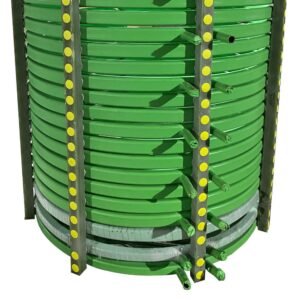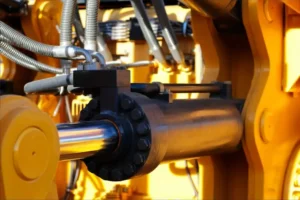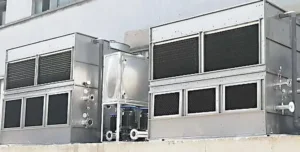What is an induction furnace?
An induction furnace is an electric furnace that uses electromagnetic induction to heat and melt metal. It is commonly used in the foundry industry to smelt and refine metals such as iron, เหล็ก, ทองแดง, อลูมิเนียม, and other alloys.
The basic working principle of induction furnaces.
The basic principle behind induction furnaces involves the use of alternating current (AC) through a coil of copper wire, generating a magnetic field. When a metal object, such as a crucible or charged material, is placed inside a coil, a magnetic field induces an electric current in the metal, called eddy current. Due to the resistance of the metal, these eddy currents generate heat, causing it to heat up and melt rapidly.
The composition of the induction furnace
The composition of an induction furnace refers to the various components and materials that make up the structure of the furnace and make it function. While the exact composition may vary by design and manufacturer, the following are common components found in induction furnaces:
เบ้าหลอม:
A crucible is a container that holds a metal charge during the melting process. It is usually made of refractory materials and can withstand high temperatures and chemical reactions with molten metal.
ขดลวดเหนี่ยวนำ:
An induction coil is a copper conductor placed around or close to a crucible. It is responsible for generating an alternating magnetic field, inducing eddy currents in the metal’s electric charge, causing it to heat up and melt.

Power supply:
The power supply provides the electrical energy required for the operation of the induction furnace. It typically consists of a high, mid-frequency power supply that converts the input power to the desired frequency and voltage suitable for induction heating.
ระบบทำความเย็น:
Induction furnaces generate a lot of heat during operation and require a cooling system to prevent overheating. The system typically includes water-cooled components such as induction coils, power cables, and other critical components to maintain optimal operating temperatures.
Control system:
The induction furnace is equipped with a control system that enables the operator to monitor and adjust various parameters such as power input, temperature, and melting cycle. It may include temperature sensors, power controllers, timers, and safety features to ensure efficient and safe operation.
Feeding system:
Larger induction furnaces usually have a charging system to facilitate the introduction of metal charges into the crucible. This can include mechanisms such as hydraulic systems, charging plungers or conveyors for transporting raw materials into the furnace.
Refractory lining:
The lining of the crucible and other related parts of the furnace are usually lined with refractory material to provide insulation and protect the structure from high temperatures and the corrosive effects of molten metal.
Exhaust system:
Depending on the application, induction furnaces can include an exhaust system to remove any fumes, gases, or by-products generated during the melting process. This helps maintain a safe working environment and promotes air quality.
The type of induction furnace
These are the main components and materials in induction furnaces. Specific designs, sizes, and additional features may vary depending on intended use and manufacturer specifications.
There are many types of induction furnaces, which can be divided into the following categories according to different applications and design requirements:
Industrial frequency induction furnace:
This type furnace adopts industrial frequency power supply (special transformer) for smelting.
เตาเหนี่ยวนำความถี่กลาง:
Medium frequency induction furnace is a common name for non-vacuum induction furnace. It uses thyristor inverter or frequency multiplier as the power supply to increase the frequency from 50HZ (60HZ) to 150~4000HZ. It is an important branch of induction furnace, mainly used for smelting special steel, with a furnace capacity of 0.10~60t.
Vacuum induction furnace:
This type of furnace is smelted and poured in a vacuum. The power supply is similar to the power supply of the medium frequency induction furnace. It is mainly used to smelt special steels and alloys. Furnace capacity 0.05~60t.
Plasma induction furnace:
This type of furnace is smelted in a shielding gas and is heated by plasma power supply and medium frequency induction furnace power supply. It is mainly used in the production of ultra-low carbon, sulfur and phosphorus special steels and alloys. The furnace capacity is 0.5~2t.
Pressurized induction furnace:
This type of furnace adopts medium frequency induction heating under the nitrogen pressure of 0.2~2.0MPa in the crucible to melt and cast high nitrogen steel containing N≥0.60%. The furnace capacity is 0.05~10t.
The induction heating process of an induction furnace
The induction heating process of the induction furnace mainly generates an alternating magnetic field in the coil through alternating current, and when the metal part is placed in the coil, the metal part induces a circulating eddy current. These currents resist the resistivity of the metal, generating precise local heat without any direct contact between the part and the coil. This heating method can effectively convert electrical energy into heat energy, and the temperature and heating zone can be precisely controlled, helping to avoid overheating or damage of the material.
The factors affecting the efficiency of induction heating are mainly frequency, power and coil design.
ความถี่:
The frequency of induction heating is usually the frequency of alternating current, generally between 50Hz and 50kHz. Higher frequencies can generate more eddy currents, which heat up faster. อย่างไรก็ตาม, the choice of frequency is also limited by the material and size of the metal, because the high-frequency signal may increase the electrical impedance inside the metal, resulting in a decrease in heating efficiency. ดังนั้น, it is necessary to select the appropriate frequency according to the specific situation in the practical application.
Power:
Power refers to the energy provided per unit of time. In induction heating, more power usually means faster heating. อย่างไรก็ตาม, too much power can cause the metal to overheat, damaging the material. ดังนั้น, it is necessary to choose the right power according to the actual demand.
Coil design:
coil is one of the key components in induction heating, and its design has an important impact on heating efficiency. ตัวอย่างเช่น, the shape, size, and position of the coil all affect the magnetic field distribution and the formation of eddy currents. Reasonable coil design can optimize magnetic field distribution and improve heating efficiency. นอกจากนี้, the choice of coil material is also important, because different materials have different electrical conductivity and heat resistance, which will affect the service life and heating efficiency of the coil.
สรุป, ความถี่, พลัง, and coil design are the main factors affecting the efficiency of induction heating. ในการใช้งานจริง, it is necessary to select and optimize according to the specific situation to improve heating efficiency and avoid material damage.







